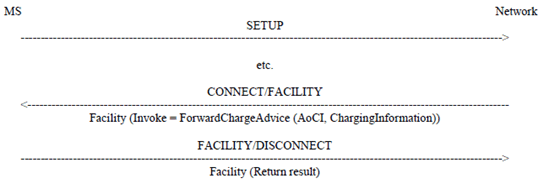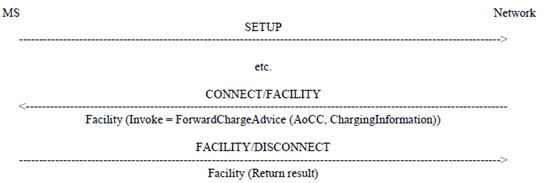TS 24.086
Advice of Charge (AoC)
Supplementary Service
V18.0.0 (PDF)
2024/03 13 p.
V17.0.0
2022/03 13 p.
V16.0.0
2020/06 13 p.
V15.0.0
2018/06 13 p.
V14.0.0
2017/03 13 p.
V13.0.0
2015/12 13 p.
V12.0.0
2014/09 13 p.
V11.0.0
2012/09 13 p.
V10.0.0
2011/04 13 p.
V9.0.0
2009/12 13 p.
V8.0.0
2008/12 13 p.
V7.0.0
2007/07 13 p.
V6.0.0
2005/01 13 p.
V5.0.0
2002/06 13 p.
V4.0.1
2002/06 13 p.
V3.0.0
1999/04 13 p.
GSM Rel-98 v7.0.1
2000/01 12 p.
GSM Rel-97 v6.0.1
1998/11 12 p.
GSM Rel-96 v5.0.1
1996/11 15 p.
GSM Phase-2 v4.5.2
1996/03 16 p.
- Rapporteur:
- Mr. Wiehe, Ulrich
Nokia Solutions & Networks (S)
Content for TS 24.086 Word version: 18.0.0
0 Scope p. 5
The present document specifies the procedures used at the radio interface (reference point Um as defined in TS 24.002) for normal operation, registration, erasure, activation, deactivation, invocation and interrogation of charging supplementary services. The provision and withdrawal of supplementary services is an administrative matter between the mobile subscriber and the service provider and causes no signalling on the radio interface.
In TS 24.010 the general aspects of the specification of supplementary services at the layer 3 radio interface are given.
3GPP TS 24.080 specifies the formats and coding for the supplementary services.
Definitions and descriptions of supplementary services are given in TS 22.004 and 3GPP TS 22.08x and 3GPP TS 22.09x-series. TS 22.024 and 02.86 are related to the charging supplementary services.
Technical realization of supplementary services is described in TS 23.011 and 3GPP TS 23.08x and 3GPP TS 23.09x-series. TS 23.086 is related to the charging supplementary services.
The procedures for Call Control, Mobility Management and Radio Resource management at the layer 3 radio interface are defined in TS 24.007 and TS 24.008.
The following supplementary services belong to the charging supplementary services and are described in the present document:
0.1 References p. 5
The following documents contain provisions which, through reference in this text, constitute provisions of the present document.
- References are either specific (identified by date of publication, edition number, version number, etc.) or non-specific.
- For a specific reference, subsequent revisions do not apply.
- For a non-specific reference, the latest version applies. In the case of a reference to a 3GPP document (including a GSM document), a non-specific reference implicitly refers to the latest version of that document in the same Release as the present document.
[1]
TR 21.905: "Vocabulary for 3GPP Specifications".
[2]
TS 22.004: "General on supplementary services".
[3]
TS 22.024: "Description of Charge Advice Information (CAI)".
[4]
TS 22.081: "Line identification supplementary services - Stage 1".
[5]
TS 22.082: "Call Forwarding (CF) supplementary services - Stage 1".
[6]
TS 22.083: "Call Waiting (CW) and Call Hold (HOLD) supplementary services - Stage 1".
[7]
TS 22.084: "MultiParty (MPTY) supplementary services - Stage 1".
[8]
TS 22.085: "Closed User Group (CUG) supplementary services - Stage 1".
[9]
TS 22.086: "Advice of Charge (AoC) supplementary services - Stage 1".
[10]
TS 22.088: "Call Barring (CB) supplementary services - Stage 1".
[11]
TS 22.090: "Unstructured Supplementary Services Data (USSD) - Stage 1".
[12]
TS 23.002: "Network architecture".
[13]
TS 23.011: "Technical realization of supplementary services".
[14]
TS 23.081: "Line identification supplementary services - Stage 2".
[15]
TS 23.082: "Call Forwarding (CF) supplementary services - Stage 2".
[16]
TS 23.083: "Call Waiting (CW) and Call Hold (HOLD) supplementary services - Stage 2".
[17]
TS 23.084: "MultiParty (MPTY) supplementary services - Stage 2".
[18]
TS 23.085: "Closed User Group (CUG) supplementary services - Stage 2".
[19]
TS 23.086: "Advice of Charge (AoC) supplementary services - Stage 2".
[20]
TS 23.088: "Call Barring (CB) supplementary services - Stage 2".
[21]
TS 23.090: "Unstructured supplementary services operation - Stage 2".
[22]
TS 24.002: "GSM-UMTS Public Land Mobile Network (PLMN) Access Reference Configuration".
[23]
TS 24.007: "Mobile radio interface signalling layer 3; General aspects".
[24]
TS 24.008: "Mobile radio interface layer 3 specification".
[25]
TS 24.010: "Mobile radio interface layer 3; Supplementary services specification; General aspects".
[26]
TS 24.080: "Mobile radio interface layer 3 supplementary services specification; Formats and coding".
0.2 Abbreviations p. 6
Abbreviations used in the present document are listed in TR 21.905.
1 Advice of Charge (Information) (AoCI) p. 6
1.1 Normal operation with successful outcome p. 6
On every successful request for an applicable telecommunications service, the served Mobile Station (MS) will be provided with charging information.
The network sends the Charge Advice Information (CAI) to the MS according to TS 22.024, TS 22.086 and TS 23.086. With this information the MS is able to calculate the units associated with the requested service in real time. In the case where the served mobile is to be charged for multi party calls, separate processes within the MS are used to calculate units appropriate to each call. For unit calculation, each call is treated in the same way as a normal "two-party" call. Any change in the charging rate during a call may be indicated to the MS.
1.1.1 Call re-establishment p. 6
When the MS detects a radio link failure, the Chargeable Duration (CDUR) shall be suspended.
If a call re-establishment procedure is attempted, the MS shall resume the CDUR when:
- an MM connection has been successfully completed; and
- a TCH has been successfully seized in the appropriate mode.
1.1.2 MS originated call p. 7
For an MS originated call, charging information is transferred to the MS as shown in Figure 1.1. The charging information is acknowledged in a FACILITY message only if the MS supports the AoCI functionality specified in TS 22.024 and TS 22.086. AoCI refers to the Advice of Charge (Information) service.

Figure 1.1: Notification to the served mobile subscriber of the charging information in case of an originated call set up
(⇒ copy of original 3GPP image)
(⇒ copy of original 3GPP image)
1.1.3 MS terminated call p. 7
For an MS terminated call, where required, charging information is transferred to the MS as shown in Figure 1.2. The charging information is acknowledged only if the MS supports the AoCI functionality specified in TS 22.024 and TS 22.086.

Figure 1.2: Notification to the served mobile subscriber of the charging information in case of a terminated call set-up
(⇒ copy of original 3GPP image)
(⇒ copy of original 3GPP image)
1.1.4 Change of charging information p. 7
To inform the MS of a change in charging information the procedure of Figure 1.3 is performed. The charging information is acknowledged only if the MS supports the AoCI functionality specified in TS 22.024 and TS 22.086.

Figure 1.3: Notification to the served mobile subscriber of a change in the charging information
(⇒ copy of original 3GPP image)
(⇒ copy of original 3GPP image)
1.2 Normal operation with unsuccessful outcome p. 8
No signalling is performed by the network if a MS fails to acknowledge receipt of charging Information.
1.3 Activation, deactivation and invocation p. 8
Activation, deactivation and invocation of the Advice of Charge (Information) supplementary service are not applicable.
1.4 Interrogation, registration and erasure p. 8
Interrogation, registration and erasure of the Advice of Charge (Information) supplementary service are not applicable.
2 Advice of Charge (Charging) (AoCC) p. 8
2.1 Normal operation with successful outcome p. 8
On every successful request for an applicable telecommunications service, the served MS will be provided with charging information.
The network sends the Charge Advice Information (CAI) to the MS according to TS 22.024, TS 22.086 and TS 23.086. With this information the MS is able to calculate the units associated with the requested service in real time. In the case where the served mobile is to be charged for multi party calls, separate processes within the MS are used to calculate units appropriate to each call. For unit calculation, each call is treated in the same way as a normal "two-party" call. Any change in the charging rate during a call may be indicated to the MS.
2.1.1 Call re-establishment p. 8
When the MS detects a radio link failure, the Chargeable Duration (CDUR) shall be suspended.
If a call re-establishment procedure is attempted, the MS shall resume the CDUR when:
- an MM connection has been successfully completed; and
- a TCH has been successfully seized in the appropriate mode.
2.1.2 MS originated call p. 8
For an MS originated call, charging information is transferred to the MS as shown in Figure 2.1. The charging information is acknowledged in a FACILITY message only if the MS supports the AoCC functionality specified in TS 22.024 and TS 22.086. AoCC refers to the Advice of Charge (Charging) service.

Figure 2.1: Notification to the served mobile subscriber of the charging information in case of an originated call set up
(⇒ copy of original 3GPP image)
(⇒ copy of original 3GPP image)
2.1.3 MS terminated call p. 9
For an MS terminated call, where required, charging information is transferred to the MS as shown in Figure 2.2. The charging information is acknowledged only if the MS supports the AoCC functionality specified in TS 22.024 and TS 22.086.

Figure 2.2: Notification to the served mobile subscriber of the charging information in case of a terminated call set up
(⇒ copy of original 3GPP image)
(⇒ copy of original 3GPP image)
2.1.4 Change of charging information p. 9
To inform the MS of a change in charging information the procedure of Figure 2.3 is performed. The charging information is acknowledged only if the MS supports the AoCC functionality specified in TS 22.024 and TS 22.086.

Figure 2.3: Notification to the served mobile subscriber of a change in the charging information
(⇒ copy of original 3GPP image)
(⇒ copy of original 3GPP image)
2.2 Normal operation with unsuccessful outcome p. 10
If timer T(AoC) (see TS 23.086) expires before the Charge Advice Information is acknowledged, the network shall release the call. The MS and network shall act in accordance with TS 24.008 network initiated call clearing procedures (see Figure 2.4).

Figure 2.4: Network release due to unsuccessful operation of Advice of Charge (Charging) service
(⇒ copy of original 3GPP image)
(⇒ copy of original 3GPP image)
2.3 Accumulated Call Meter is equal to or greater than ACMmax p. 10
If the change stored in the Accumulated Call Meter (ACM) is equal to or greater than the maximum value specified by ACMmax, then the MS shall initiate call clearing giving a specific cause value for this situation as indicated in Figure 2.5.

Figure 2.5: Mobile station releases the call due to ACM being equal to or greater than ACMmax
(⇒ copy of original 3GPP image)
(⇒ copy of original 3GPP image)
2.4 Activation, deactivation and invocation p. 10
Activation, deactivation and invocation of the Advice of Charge (Charging) supplementary service are not applicable.
2.5 Interrogation, registration and erasure p. 10
Interrogation, registration and erasure of the Advice of Charge (Charging) supplementary service are not applicable.